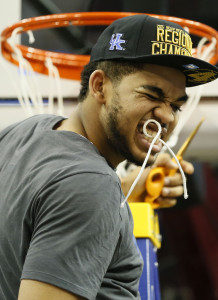It’s not easy to stand out when you’re surrounded by All-Americans, but Trey Lyles made a serious impression during his lone season at Kentucky. The 6’10” forward caught the attention of NBA scouts while helping the Wildcats compile a 38-1 record. Although he averaged just 23 minutes in coach John Calipari’s platoon system, Lyles scored 8.7 points and collected 5.2 rebounds per game and displayed skills that should transfer well to the NBA.
Lyles was on the NBA’s radar before he arrived at Kentucky. He was highly recruited out of Arsenal Tech High School in Indianapolis, where he was named Indiana’s “Mr. Basketball” in 2014. Born in Saskatoon, Canada, he has represented both Canada and the United States in international competition and was Canada’s second-leading scorer in the the 2013 FIBA Under-19 World Championship.
Lyles is ranked as the 19th-best prospect by Jonathan Givony of DraftExpress and 12th by ESPN’s Chad Ford. At the NBA’s recent draft combine, he measured 6’9″ without shoes and has a 7’1.5″ wingspan. He projects as a power forward in the NBA, but at 241 pounds, he has the bulk to play center in a small-ball lineup.
Givony spoke highly of the Kentucky player’s talents, writing, “Lyles has a very nice skill level for a player his size.” He also compliments Lyles’ footwork and soft shooting touch, along with his back-to-the-basket moves, although he didn’t get to display that part of his game much at Kentucky.
Lyles also developed an effective perimeter game, Givony notes, with the ability to attack defenders off the dribble in either direction, along with “crafty spin-moves with strong body control and choppy footwork.” He foresees that working to even greater advantage for Lyles when he goes back to his natural positions in the NBA and is driving the ball against opposing power forwards and centers.
Although he didn’t get to show his talents during games as much as other potential draftees, Lyles claims he benefited from being around so many other great players at Kentucky. Lyles told Keith Langlois of Pistons.com that the talent level resulted in highly competitive practices every day.
“It was great,” Lyles said at the combine. “You’re on a team with nine McDonald’s All-Americans, guys who have to share with one another and transition into the NBA. I think it helped all of us out.”
It also forced Lyles to make some adjustments to his game. Playing alongside probable top pick Karl-Anthony Towns and likely top-10 selection Willie Cauley-Stein, Lyles was often out of position at small forward. The experience challenged him to develop his perimeter game, both as a shooter and ball handler. Lyles never did find his three-point shot, connecting on just 4 of 29 attempts from behind the arc for the season. However, he displayed a soft touch from everywhere else, shooting 46% from the field and 74% from the line. He was especially tough to stop once he reached the paint, hitting 50% of his post-up attempts and finishing on 59.5% of his shots around the rim.
“I’ve been working on mid-range stuff since I was young,” Lyles said at the combine, according to Langlois. “My dad always taught me that mid-range is where the game’s going to be played at, where you’re going to make your money. So it’s something I’ve always had in my game.”
Lyles grew up as a coach’s son, and his father, Tom, tells Jerry Tipton of the Lexington Herald-Leader that he constructed “brutal” workouts for his son from the time he was in elementary school.
“At a very early age, he was doing a man’s workout,” Tom Lyles said.
That usually meant three sessions a day — before school, after school and after dinner. The drills were designed to improve the younger Lyles’ shooting, dribbling and conditioning — and to build a work ethic.
All that time in the gym helped Lyles develop an NBA-style game at a young age. In addition to his mid-range shooting, Lyles gets high marks from scouts for his ability to thrive in the pick-and-roll offense and to pass or create shots for himself in transition, according to Andy Erk of SB Nation. His size should also help him develop as an effective low-post defender once he reaches the pros. His perimeter defense was a concern in college, but much of that could be attributed to playing out of position. Scouts are also worried about his lack of explosiveness and lateral quickness, as Erk notes.
Despite playing at one of the highest-profile college programs in the nation, Lyles enters the draft as a bit of a mystery. Teams may think they know how he will develop in the NBA, but playing out of position at Kentucky and being on the court for barely half the game could cloud their judgment. Lyles might be a worthwhile gamble for a lottery team, or he could be the type of player who takes a year or two to adjust to the NBA.
